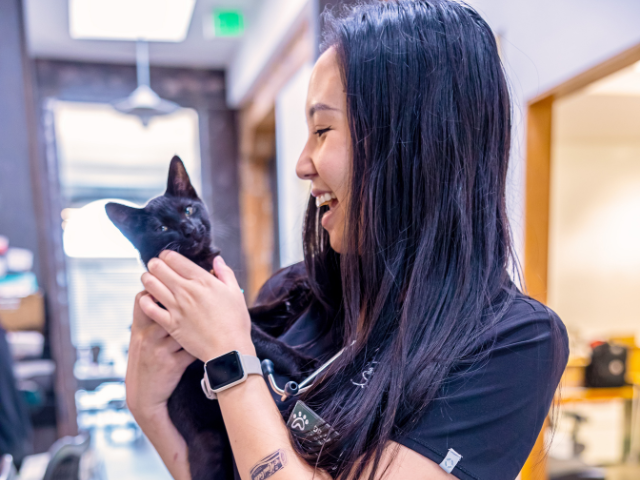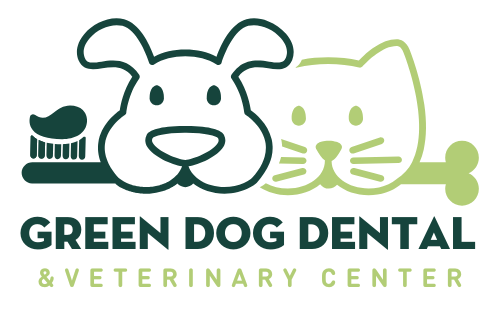
Diagnostic Imaging
Diagnostic Imaging (radiology) refers to using a variety of non-invasive technologies to acquire images in order to help make a diagnosis. There are a variety of advanced imaging machines and techniques available at Green Dog, including digital radiography (X-rays), Computed tomography (CT scan), and ultrasound. These are used to examine and evaluate different structures within your pets body. With consultation from radiologists Green Dog Doctors interpret the results of those images to assist in diagnosis or to guide other therapy.
There may come a time when your pet needs an advanced imaging study, such as X-rays, ultrasound, or computed tomography (CT scan). Green Dog is proud to be one of a very few out-patient clinics offering these services. Access to advanced technology is part of what drives great patient care. Green Dog has these technologies at our disposal, and we offer their use on an out-patient basis. If your pet needs an advanced imaging study, your veterinarian will recommend and schedule an appointment. (often same-day!)
Imaging Services:
- Computed Tomography (CT) Scanning
- Digital Radiography
- Ultrasonography
- Abdominal Ultrasonography-Abdominocentesis And Cystocentesis
- Thoracic Ultrasonography / Thoracocentesis
- Ultrasound-Guided Core-needle Biopsy
- Ultrasound-Guided Fine Needle Aspiration
Computed Tomography (CT) Scanning
Computed Tomography (CT) is a diagnostic tool that uses x-rays to obtain cross-sectional images of the body. CT is commonly used to image:
- Dental Disease
- Lungs and Chest
- Orthopedic conditions such as elbow dysplasia, complex fractures, tumors or infections, etc.
- Skull, nasal cavity and sinuses, middle or inner ear disease.
- Can be used to diagnose vascular liver shunts and other abdominal diseases such as adrenal tumors or liver tumors
- Assisting a surgeon to plan a difficult surgery to remove or treat these abnormalities.
- CT can also be used to guide a biopsy of an abnormality within the body less invasively than with surgery. CT can be used to develop 3-D printing for surgical planning and practicing.
Veterinary patients need to be heavily sedated or anesthetized for CT scans, so that they will remain still long enough for the examination. Every patient that presents for a CT scan will receive a thorough physical exam, and will have a review of recent bloodwork and other testing done prior to anesthesia to ensure they are good candidates for anesthesia. Every patient anesthetized at our clinic is closely monitored by a veterinarian and veterinary technician. while under sedation or anesthesia.
Digital Radiography
Radiographs, or x-ray studies, use x-rays to create an image of the body. This is the most frequently used form of veterinary imaging. Digital radiography does not use film, so it is faster to obtain the images and also makes it easy to share images with other veterinarians such as radiologists. Radiographs are used to diagnose disease in the chest, abdomen, and musculoskeletal system. Contrast studies of the gastrointestinal and urinary tract may also be performed.
Digital Ultrasonography
Green Dog offers ultrasound (ultrasonography) examinations as a non-invasive procedure to evaluate internal organs. Ultrasound studies are most helpful to evaluate soft tissue and fluid structures. Moving organs may be evaluated during motion, such as the beating heart, flowing blood and contracting intestines.
Abdominal Ultrasonography-Abdominocentesis and Cystocentesis
Ultrasound studies are most helpful to evaluate soft tissue and fluid structures. Gastrointestinal foreign material may be identified on an ultrasound exam when it is not apparent on radiographs. At times a sample will need to be collected from the abdominal cavity, this process is known as abdominocentesis. A urine sample is often collected from the bladder with ultrasound-guidance to submit common tests such as urinalysis or urine culture. This process is known as cystocentesis.
Thoracic Ultrasonography / Thoracocentesis
Ultrasound studies are most helpful to evaluate soft tissue and fluid structures. Moving organs may be evaluated during motion, such as the beating heart, flowing blood and fluid in the chest. Collecting a sample from the chest cavity using ultrasound-guidance is known as thoracocentesis.
Ultrasound-Guided Biopsy and Fine Needle Aspiration
Following assessment of an organ and the surrounding structures, ultrasound imaging is used to guide needle placement into a selected tissue or cavity. A sample of tissue or fluid may be drawn through the needle as an aspirate to analyze the cells or other contents of the sample (cytology and microbiology). A larger needle may be used to retrieve a small piece of solid tissue for a core-biopsy to analyze the architecture of the tissue (histopathology). It may be necessary to assess a pet’s clotting ability prior to this sampling technique. Ultrasound guidance is commonly used to remove fluid from the chest cavity (thoracocentesis) and abdominal cavity (abdominocentesis).
